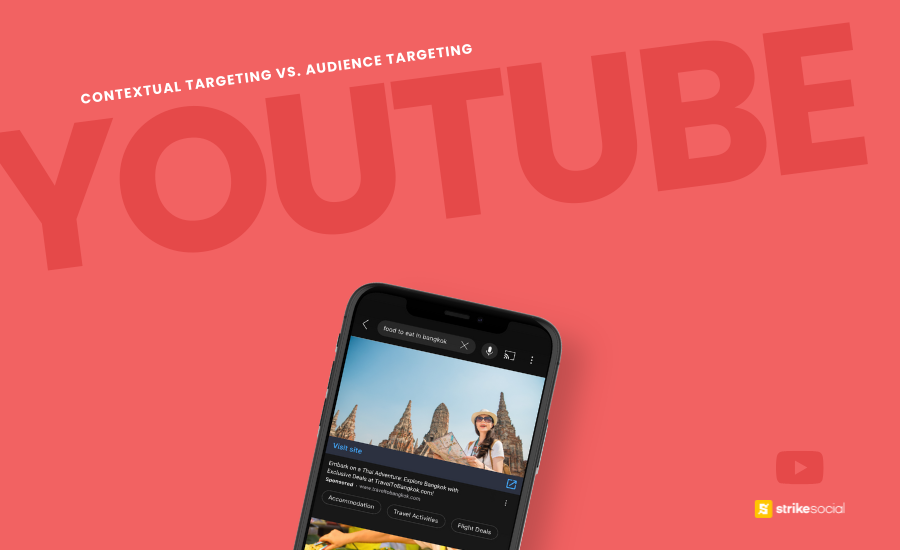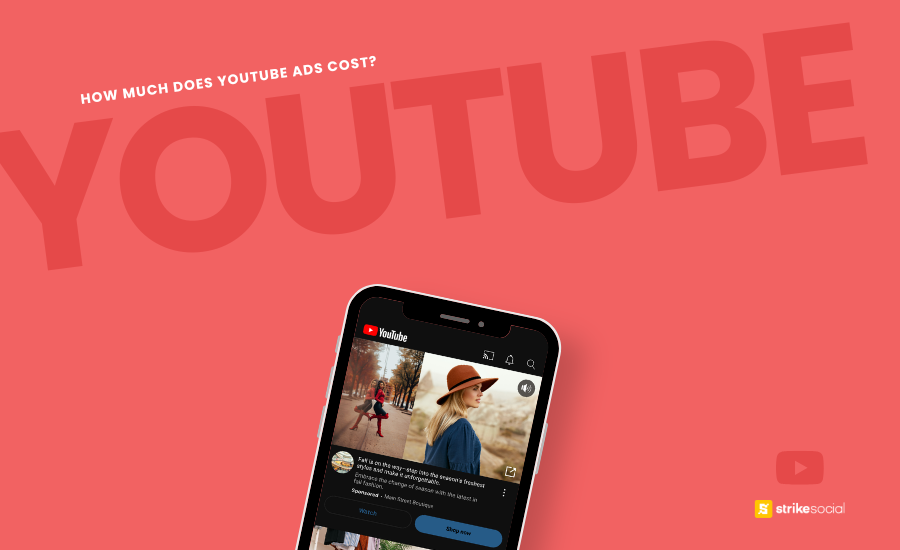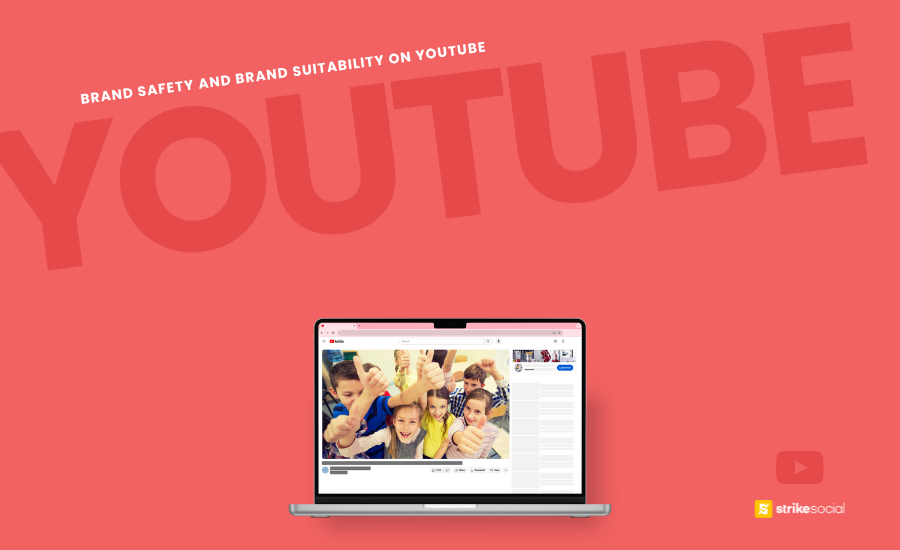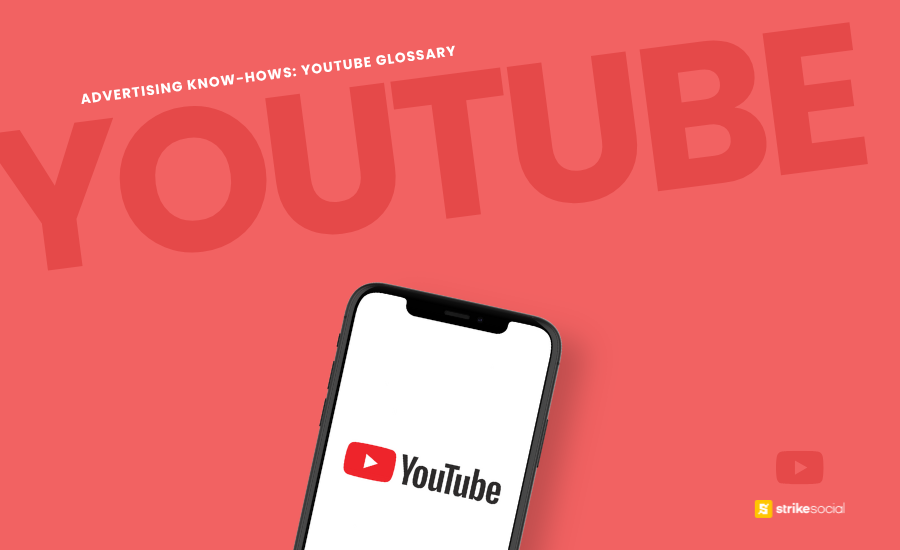Strike Overview
- Marketing on an unfamiliar platform can be challenging, but fortunately, you have Strike Social’s YouTube advertising glossary to assist you.
- YouTube is ubiquitous these days, with users spanning all age demographics, from 18 to 65 and beyond.
- Whether you’re a seasoned YouTube user or just starting out, having a comprehensive glossary of YouTube advertising terms can be invaluable for navigating this vast platform.
Jump to Section
This post was updated in June 2025 to provide you with the latest information.
How Well Do You Understand YouTube Advertising Terms?
Moving from being a viewer to a creator to a marketer mirrors the journey of brands stepping into YouTube advertising. Together, we’ll explore and understand the ins and outs of YouTube video advertising terms. As you get to a deeper stage, you may find some familiar terms and some that can be very new to you.
The global growth of YouTube advertising is undeniable, with a projected growth of 14% YoY. So before jumping into the complex stages, let’s start by revisiting the fundamentals as your starting point.
Glossary of Terms for YouTube Content Creators
Before placing ads onto YouTube, understanding the platform’s basic terminologies is crucial to effectively manage your channel and engage with your audience. This section of our YouTube advertising glossary delves into essential terms relevant to uploading videos, channel management, and viewer interaction.
Introduction to YouTube Marketing Terms
Crafting successful YouTube marketing strategies requires a solid understanding of the core concepts specific to the platform. In this section, we provide an overview of the fundamental vocabulary essential for developing effective marketing campaigns on YouTube.
YouTube Advertising Management Terms for Beginners
Gain the knowledge needed to launch and manage successful advertising campaigns on YouTube, setting the stage for future growth and optimization. This section offers a comprehensive guide to basic campaign metrics and ad management on YouTube.
YouTube Advertising Glossary for Media Buyers
Explore a comprehensive range of marketing terms designed to arm media buyers with the knowledge and tools necessary for executing highly targeted YouTube campaigns.
Ad Copy: The written text that appears alongside your video ad, including the headline, description, and call to action (CTA).
Ad Suitability: Aligning video ads with contextually relevant content suitable for the target audience. With YouTube hosting diverse content types, ad suitability is crucial to ensure alignment with the content.
Affinity Audiences (Custom Intent): Allows for the creation of more personalized audience groups tailored to your brand, as opposed to broader audience segments. For instance, instead of targeting “Basketball Fans,” a brand focusing on the sports season might opt to target individuals interested in “College Basketball” specifically.
Further Reading

YouTube Contextual Targeting vs YouTube Audience Targeting
When planning a YouTube campaign, your choice between contextual and audience targeting can shape your results. Explore which method aligns better with your strategy and helps you connect with the most relevant viewers.
Analytics: A central hub within YouTube Studio that provides creators and marketers with valuable insights into their channel’s performance. It offers a comprehensive overview of key metrics and data visualizations to help users understand how their content is resonating with viewers and identify areas for improvement.
Audience Segments: Audience groups are categorized by their activity using Google products or estimated based on likely interests in specific content.
Awareness and Consideration: The campaign objective focused on increasing the number of viewers reached by your video ad.
Bid Strategy: The method you use to determine how much you are willing to pay for each ad impression or click.
Brand Safety: YouTube brand safety ensures your ads are displayed alongside appropriate content aligned with your brand image.
Bumper Ads: Short, non-skippable YouTube ad formats lasting six seconds or less, ideal for quick brand messaging or product teasers.
Call to Action (CTA): A clear and concise message within your video ad or content encourages viewers to take a specific action, like visiting your website or learning more about your product.
Campaign Objective: The specific goal you aim to achieve with your advertising campaign (e.g., brand awareness, lead generation, website traffic and action).
Cards: Interactive elements appear during your video, linking to other videos, playlists, or websites.
Category Exclusion: Using category exclusion targeting for YouTube enables you to exclude your ads from appearing on video categories that don’t align with your product or brand on YouTube. Examples of the categories include Content suitable for families, Games (fighting), Health (sensitive), and more.
Channel: Your personalized space on YouTube to house your videos, playlists, and community.
Clicks: The number of times viewers click on your ad, redirecting them to your desired landing page.
Click-through Rate (CTR): The percentage of viewers who click your ad after seeing it is calculated as (clicks/impressions) x 100. This metric indicates ad effectiveness.
Comments: Textual responses viewers leave on your video, foster interaction and feedback.
Community Guidelines: A set of established rules that creators and viewers must follow to maintain a safe, respectful, and positive environment on the platform. These guidelines outline what type of content is and isn’t allowed on YouTube.
Connected TV (CTV) Advertising: Lets you reach audiences through YouTube ads on smart TVs and streaming devices. These relaxed viewing environments can drive up to 78% video completion rates.
Content Suitable for Families: Videos deemed appropriate for viewers of all ages, including children. Excluding “Content suitable for families” from YouTube advertising prevents views and clicks from minors.
Content Theme Exclusions: A feature within YouTube advertising that allows advertisers to exclude their ads from being displayed on videos, websites, or apps associated with specific themes that might not align with your brand identity. Here’s how you can set up your YouTube content theme exclusions.
Contextual Targeting: By selecting relevant keywords or topics, this approach ensures that your ads are aligned with content that shares relevance. With YouTube contextual targeting, your ads are strategically placed within YouTube search results and video content.
Conversion Tracking: Setting up tools to track specific actions viewers take after seeing your ad (e.g., making a purchase, signing up for a newsletter).
Copyright Claim: A notification you might receive if your content contains copyrighted material owned by someone else. If your video includes third-party content like music or clips, consider adding a YouTube disclaimer to reduce the risk of claims. A clear disclaimer can help explain how your use may fall under fair use, such as for commentary or educational purposes.
Copyright Strike: A penalty is issued by YouTube if your content infringes on someone else’s copyright, potentially impacting your channel.
Cost per Acquisition (CPA): The average cost you pay for each time a viewer takes a desired action like a website visit or purchase after seeing your ad.
Cost per Mille (CPM): Refers to the metric that represents the cost you pay for every thousand impressions your video ad receives.
Cost per View (CPV): The average cost you pay for each time your video ad is viewed, regardless of whether viewers click on it.
Further Reading

Planning Your Budget with YouTube Ad Cost Guides
Track key cost metrics to optimise your YouTube ad spend. Understand average CPC, CPM, and CPV rates on YouTube so you can plan smarter and allocate your budget with confidence for future campaigns.
Custom Audiences: Targeting existing customer databases or website visitors through uploaded lists, allowing for highly personalized ad campaigns.
Daily Budget: The maximum amount you are willing to spend on your ad campaign each day.
Demographics: Targeting viewers based on factors like age, gender, parental status, and household income.
End Screen: Call-to-action elements are displayed at the end, directing viewers to other videos or your channel.
Engagement: The level of interaction your videos receive is measured by comments, likes, shares, and saves.
Exclusion Targeting: Excludes specific keywords and placements from seeing your ads to avoid irrelevant viewers.
Frequency Capping: Setting a limit on the number of times a specific viewer sees your ad within a certain timeframe.
Impressions: The number of times your video ad is displayed on viewers’ screens.
In-feed Video Ads: Consists of a video thumbnail and text. Users can watch the autoplay inline or click on the thumbnail to view the full video.
In-Market Audiences: Targets viewers actively researching or considering products or services related to your offering.
Inventory Types: YouTube inventory types refer to the scope of content where your video ads can be displayed. You can opt for expanded inventory, standard inventory, or the more restrictive limited inventory.
Landing Page: The web page viewers are directed to after clicking on your YouTube ad. It should be relevant to your ad and encourage the desired action.
Leads: A campaign objective aimed at attracting potential customers who express interest in your product or service by delivering targeted video content.
Live Streams: Real-time broadcasts allow you to interact directly with viewers at the moment. With Demand Gen campaigns, you can build momentum and ensure strong attendance for your live stream event.
Maximize Clicks: Automatically adjust bids to receive the most clicks on your ad within your budget.
Monetization: Enabling your channel to generate revenue through ads, sponsorships, and merchandise sales.
Multi-touch Attribution: Assigns credit for a conversion to all touchpoints a viewer interacts with (ads, website visits, etc.).
Negative Keyword Targeting: A brand safety measure involves assigning keywords that you don’t want your ads to appear with.
Further Reading

Brand Safety and Suitability: Ensuring Safe and Relevant Contexts for Your YouTube Ads
From content filters to exclusion settings, YouTube offers features that help control where your ads show up. Understand how to implement these brand safety and suitability tools to ensure your campaigns stay in the right context.
Playlist: A curated collection of your videos grouped together around a specific theme or series.
Programmatic Buying: Automated buying and selling of ad inventory in real-time, allowing for greater efficiency and optimization.
Quartile Views: A metric used in YouTube advertising reports, indicating the percentage of viewers who watched your ad to a specific point (e.g., 25%, 50%, 75%, or completion).
Retargeting: Retargeting on social media, specifically on YouTube, involves targeting viewers who have previously interacted with your brand or content with additional ads to maintain awareness and encourage further engagement.
Sales Objective: A campaign goal aimed at prompting viewers to take a specific action, such as making a purchase, after watching your video ads.
Shorts Ads: These video ads play on YouTube Shorts, YouTube’s own vertical and short-form video feed. Users can swipe or scroll to skip the ad at any time.
Skippable In-stream Ads: Video ads appear before, during, or after other YouTube videos, capturing viewers’ attention between content. After 5 seconds, users have the option to skip the rest of the ad to continue watching the video you appeared with.
Sponsored Content: Collaborations with other creators where they promote your brand or product within their videos, leveraging their established audience reach.
Subscribers: Users who choose to receive notifications when you upload new content, forming your core audience. By building campaigns that increase YouTube subscribers, you can foster a stronger community that regularly watches, shares, and interacts with your videos.
Target CPA: Sets a target cost per acquisition (CPA) and adjusts bids to acquire customers at that cost.
Thumbnail: The preview image representing your video in search results and browsing lists is crucial for attracting viewers.
Topic Exclusions: A feature within YouTube advertising similar to Content Theme Exclusions, but with a more granular level of control. It allows advertisers to exclude their ads from channels or videos tagged with specific topics such as news, politics, religion, controversial regions, drugs, crime, and mature men’s interests.
Trueview Ads: Skippable video ads with different lengths (in-stream and discovery) and billing options [CPV or cost per thousand impressions (CPM)], offering flexibility for diverse campaign goals.
Video Action Campaign (now Demand Gen): This is a type of YouTube campaign designed to drive specific actions from viewers, such as website visits, product purchases, app downloads, or lead generation.
Video Ad Safety Promise: This is a commitment by YouTube to ensure a baseline level of brand safety for video ad placements. The Video Ad Safety Promise guarantees that content containing extremely controversial topics like terrorism, nudity, and recent sensitive events will be automatically excluded from monetization, meaning ads won’t be displayed on such content.
Video Ad Specifications: The technical requirements for your video ad, such as video format, aspect ratio, and file size.
Video Discovery Ads: Ads displayed alongside search results and suggested videos, based on viewer interests and search queries.
Video Reach: A campaign objective subtype that emphasizes reaching a wider audience or repeatedly reaching the same individuals. You are charged for every 1,000 impressions of your ads displayed.
Video Views Campaign: This campaign objective subtype aims to garner views and interactions from individuals with a higher likelihood of being interested in your products or brand. Payment is made only when someone opts to watch your ad. Your VVC ads may appear as skippable in-stream, in-feed, and Shorts ads.
View rate (VR): The average of views over the impressions your ad has received (view rate benchmarks may vary depending on objective). In this context, “Views” refers to the number of times users actively watch or engage with an ad, while “Impressions” denote the total number of times the ad is displayed or served to potential viewers.
Views: The number of times viewers watch your video content.
Watch Time: The total duration viewers spend watching your videos is vital for engagement and monetization.
YouTube Kids: A separate app and website experience curated specifically for children. It offers content that is deemed safe and appropriate for younger audiences. For advertisers, we recommend excluding these when launching a YouTube campaign.
Your Comprehensive Guide to YouTube Advertising Terms Explained
Congratulations on completing our comprehensive guide to YouTube advertising terms! With this newfound knowledge, you’re better equipped to navigate through YouTube advertising with confidence. Don’t hesitate to bookmark this page for quick reference whenever you need a refresher. While it’s not necessary to memorize everything at once, having a go-to resource will come in handy as you continue to refine your advertising strategies.
Interested in expanding your advertising knowledge to other platforms? Check out our LinkedIn and Facebook glossaries! And for ongoing insights and tips straight to your inbox, subscribe to our newsletter today. We’re committed to providing you with valuable resources to enhance your advertising expertise.
Article by
Lee Baler, Strike Social’s VP of Sales & Strategy
Lee leads global strategy, helping clients and agencies maximize YouTube and paid social performance. Constantly tracking industry trends, he translates insights into strategies that help brands stay competitive and achieve sustained profitability.








